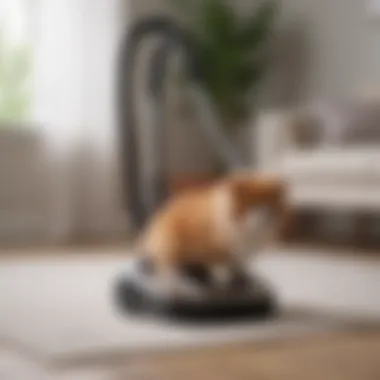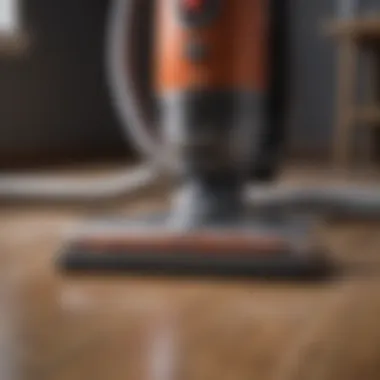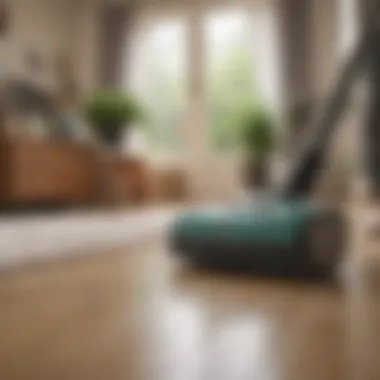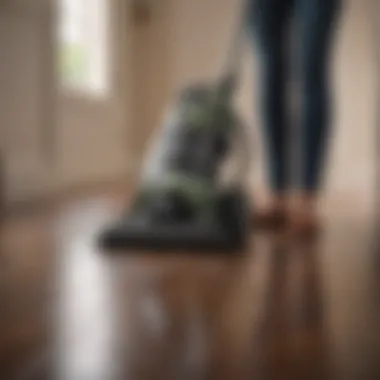Choosing the Best Vacuums for Pet Hair Management


Intro
In the world of pet ownership, fur is often as much a part of the home as the furniture itself. While our furry friends bring joy and companionship, they also come with their unique challenges - chief among them is the constant battle against pet hair. From the couch to the carpet, this relentless fluff has a sneaky way of embedding itself in every nook and cranny of our living spaces. Therefore, investing in a reliable vacuum designed specifically for pet hair isn’t just a matter of convenience; it is essential for maintaining a clean and welcoming home.
This guide delves into the intricacies of selecting the perfect pet hair vacuum, focusing on what makes these machines effective for tackling pet-related messes. Understanding the performance metrics, design features, and user experiences can demystify the often-overwhelming sea of choices available on the market today. As we embark on this journey, we will explore vital elements that factor into the effectiveness of pet hair vacuums, ensuring you emerge with a well-informed perspective that can greatly enhance your cleaning routine.
Understanding the Challenge of Pet Hair
Owning a pet comes with its share of joys, but it also comes with the never-ending battle of managing fur. This constant challenge significantly influences the choice of vacuum cleaner, as standard models often fall short. An effective pet hair vacuum not only alleviates cleanup but also contributes to a healthier home environment. The critical nature of understanding pet hair extends beyond mere aesthetic considerations—it impacts allergens, mental well-being, and the overall habitability of your home.
The Nature of Pet Hair
Pet hair, unlike conventional dust and debris, often seems to have a mind of its own. It's lighter and finer, making it easy for it to travel through the air and settle into every nook and cranny. Did you know that pet hair can cling stubbornly to fabrics and carpets? This is due to static charge and its fine structure, which allows it to intertwine with fibers, making it tougher to get rid of.
One unique aspect of pet hair is that it can instigate allergies. Dander—tiny flakes of skin often mistaken for hair—also contributes significantly to the allergic reactions many pet owners face. Therefore, tackling this issue means choosing a vacuum that not only picks up hair but also helps minimize allergens in the home.
Common Issues Faced by Pet Owners
Many pet owners can relate to the frustration that comes with maintaining cleanliness amidst the fur storm. Common problems typically include:
- Persistent Fur: Standard vacuum cleaners often require multiple passes to effectively pick up pet fur, leading to inefficiency.
- Clogs and Tangling: Pet hair can entangle in the vacuum's brush roll or cause clogs in the filtration system, decreasing performance over time.
- Odors: Along with hair, pets often bring odors that linger. A vacuum that can handle fur but also combat smells is essential.
- Allergens: Beyond hair, the dander contributes to indoor allergens, necessitating a vacuum cleaner with strong filtration capabilities.
Different Types of Pet Hair Vacuums
When it comes to effectively managing pet hair, understanding the different types of vacuums available is essential. Each category of vacuum cleaner has specific features that cater to various cleaning needs and environments. Recognizing the distinctions can help you find the right tool to tackle those stubborn tufts of fur that seem to appear out of nowhere. Let’s explore the main types of pet hair vacuums—each with its own set of advantages and considerations.
Upright vs. Canister Vacuums
Upright and canister vacuums represent the two big players in the market. An upright vacuum typically stands tall and is designed for ease of use over large areas, making it a popular choice among pet owners. It tends to have a stronger suction power and larger dirt capacity, allowing for prolonged cleaning sessions without frequent emptying. For homes with carpeted floors, this style is particularly valuable, as it's often better at deep-cleaning fibers, pulling out hair and dirt that settles at the base.
On the flip side, canister vacuums offer a high degree of versatility. They feature a separate canister that houses the motor and dust collection, linked to a hose for maneuverability. This design allows for easier cleaning in tighter spaces, such as under furniture or around intricate layouts. If your home consists of a mixed bag of surfaces—hard floors, carpets—canister vacuums are usually a smart choice due to their adaptable cleaning heads.
Considerations:
- Upright benefits: Stronger suction, larger bin capacity for less frequent emptying.
- Canister advantages: Easy to maneuver, excellent for diverse flooring types.
Robotic Vacuum Cleaners
Robotic vacuums have revolutionized the way pet owners tackle cleaning tasks. These autonomous devices glide around your home, giving you more time to chill or take care of other chores. Not only do they provide a hands-off approach, but many come equipped with specialized brushes designed to lift pet hair from both carpets and floors.
The best part is the scheduling feature; you can set it to clean while you’re out, ensuring that your home remains fur-free and tidy. However, some users find that robotic vacuums can struggle with dense carpets or large clumps of fur. They might not reach the corners and might need assistance to properly dock or empty their bins.
Considerations:
- Advantages: Saves time, suitable for daily upkeep, often includes smart technology.
- Limitations: May lack deep-cleaning capabilities compared to traditional vacuums.


Stick Vacuums for Quick Cleanups
Stick vacuums provide a nimble solution for pet owners looking for fast cleanup options. They are often lightweight and designed for convenience, making them easy to grab when a minor mess occurs. Stick vacuums typically pack a good punch in terms of suction, but might not handle heavy-duty cleaning as efficiently as their larger counterparts.
For example, if your fur baby has a knack for shedding right before guests arrive, a stick vacuum can quickly whisk away the evidence in a jiffy. Many models are cordless, adding to their versatility. However, their limited dirt capacity means that they might need to be emptied more frequently than larger models.
Considerations:
- Pros: Lightweight, easy to store, ideal for quick cleanups.
- Cons: Limited dirt capacity, less suitable for deep-cleaning.
With all these options, it’s clear that the type of vacuum cleaner you choose plays a crucial role in your overall pet hair management strategy. Evaluate your specific living situation—like the size of your home, types of flooring, and how often cleaning is needed—to determine which approach suits your lifestyle best.
"Selecting the right vacuum isn't just about brand or price; it's about finding the perfect fit for your cleaning habits and your furry companions."
By thoroughly assessing each type, you can make a smart choice that enhances your cleaning routine, ensuring a fur-free environment that is welcoming for both guests and pets alike.
Key Features to Consider
When you're knee-deep in pet hair during shedding season, having the right vacuum can turn that chaotic mess into a clean haven. Selecting the right vacuum requires pinpointing specific features that will meet your household's needs below the surface. Power, filtration efficiency, ease of use, and sound levels are crucial elements that impact your vacuum's performance. Here’s a look at why these features matter, especially for pet owners.
Suction Power
Suction power is essentially the beating heart of a vacuum cleaner—it’s the difference between merely moving pet hair around and actually sucking it up where it belongs: in the dust bin. Higher suction usually means better cleaning. When evaluating suction power, it's key to consider the type of pet hair your vacuum needs to tackle. Long-haired cats, for example, can leave behind stubborn strands that short-haired dogs might not.
To gauge suction power, look for vacuums with adjustable settings, as this allows you to maintain optimum performance on various surfaces, be it in your living room or on your plush carpets.
"A vacuum's ability to handle both fine hairs and larger debris translates directly into convenience for the user."
Filtration Systems
Now, let’s talk about filtration systems. Pet owners know well enough that pet dander can trigger allergies; thus, choosing a vacuum with a solid filtration system can't be overstated. HEPA filters, in particular, are the gold standard here. These filters are adept at trapping tiny particles, ensuring that what ends up back in the air is free from allergens.
Moreover, a good filtration system helps maintain the performance of your vacuum over time, reducing those dreaded filter replacements. This aspect is something many owners overlook until they start sneezing mid-clean.
Weight and Maneuverability
In the game of vacuums, how heavy a machine is can really change the tide. If your vacuum feels like you're dragging a dead weight across the floor, cleaning can quickly become a chore. Light-weight models are particularly handy for those high-traffic areas where you need to make quick passes. Maneuverability matters too. A vacuum’s ability to navigate around furniture and into corners can significantly elevate cleaning efficiency.
Consider the handle design and wheel type, as these aspects affect how easily you can steer the vacuum. A vacuum that glides easily may save you time and back strain.
Noise Levels
Lastly, but certainly not least, let’s address noise levels. While it can be tempting to grab a vacuum that boasts tremendous power, it’s wise to analyze how obnoxiously loud it sounds. Some pets get spooked by vacuum noise, causing anxiety that can lead to other messes. Look for vacuums designed with a quiet operation feature, which balances power and sound.
A quiet vacuum means you can continue your routine chores or engage in conversation without needing to raise your voice.
In summary, keeping these features in mind—suction power, filtration systems, weight and maneuverability, and noise levels—can arm you with the needed knowledge to make an informed decision when choosing a vacuum. Each feature plays its part in crafting a tool that does not just clean but also improves the overall quality of your home environment.


Analyzing Popular Pet Hair Vacuums
In this section, we’ll explore the landscape of pet hair vacuums, digging into the choices pet owners encounter when selecting the right tool to tackle their furry friends' messes. Analyzing these popular vacuums helps in understanding not just the top performers in the market but also the specific features that can make cleaning more effective and efficient. It’s about recognizing what’s out there and figuring out what aligns with your cleaning style and household needs.
Having a vacuum that’s specifically designed for pet hair can transform the experience of living with pets. Beyond simply picking up visible fur, these machines often feature advanced mechanics and technology that address deeper issues, like dander and allergens, which can be a real nuisance for sensitive residents. Frequent users can testify that not all vacuums are created equal, and investing in a highly rated model could spare you from frustration.
Top-Rated Upright Vacuums
Upright vacuums often lead the pack when it comes to performance, especially for thick carpets where pet hair tends to cling on like a stubborn guest. Many of them come equipped with powerful motors that enhance suction capacity, making them perfect for homes with multiple furry inhabitants. Brands like Shark and Dyson have carved out strong reputations for their upright models.
Features to look for include:
- Brush Roll Technology: Designed to lift stubborn fur from carpet fibers.
- Advanced Filtration: HEPA filters can trap allergens, making air cleaner for both pets and their humans.
- Capacity: A larger dust bin is essential for homes with heavy shedding.
User attention falls not only on features but also on practical aspects like ease of use and maintenance. According to reviews, the Shark Navigator consistently ranks high for its balance of price and performance.
Best-Selling Canister Models
Canister vacuums tend to have a sneaky advantage; their maneuverability allows access to tight spots that upright vacuums might dare to tread lightly around. For pet owners who have multiple surfaces—like tiles, hardwood, and carpets—a canister vacuum such as the Miele Complete C3 can adapt effortlessly.
When examining the best-sellers, consider:
- Versatile Attachments: Look for tools like crevice wands and upholstery brushes to tackle various surfaces.
- Variable Suction Control: This feature helps in adjusting power based on the surface type—no need to blast your delicate upholstery.
- Lightweight Design: A vacuum that’s cumbersome can lead to reluctance; choosing a model that feels manageable is critical.
Many users praise the Bissell Zing for its affordability and adaptability, making it a strong contender for budget-conscious pet owners.
Leading Robotic Vacuums
Robotic vacuums are the futuristic solution many pet owners find appealing. While they might lack the raw suction power of some traditional models, they shine in regular maintenance of fur on hard surfaces. Machines like the iRobot Roomba are designed to be both efficient and user-friendly.
Key points to remember include:
- Smart Navigation: Advanced models can map your home and avoid bumps, leading to efficient cleaning routes.
- Scheduled Cleaning: This allows pet owners to run the vacuum when they aren’t home, which can be a sanity savior.
- Self-Cleaning Functions: Some have features that tidy up their brushes, reducing the effort required.
Consumers have expressed satisfaction with the Neato Botvac, especially for its strong suction and smart design that allows it to corner well—a common challenge in pet-filled homes.
"Choosing the right vacuum is more than just about cleaning; it’s about improving your quality of life with your pets."
Ultimately, the market is full of options catering to pet owners. Balancing your specific needs with the right vacuum type can lead to a cleaner home and happier pets.
User Experiences and Reviews
When it comes to selecting a vacuum specifically designed for tackling pet hair, user experiences and reviews play a crucial role. Unlike product specifications, real-life accounts from other pet owners reveal how well these vacuums perform in everyday situations, offering a lens into what potential owners can expect. These insights can be invaluable, helping buyers make informed decisions that can save them from costly mistakes or major regrets.
Insights from Pet Owners


Pet owners often share their practical insights based on daily use of their vacuums. This first-hand account sheds light on features that may not be highlighted in product descriptions.
- Effectiveness on Various Surfaces: Many users discuss how their vacuum holds up on different types of flooring. For instance, a vacuum that excels on carpet might struggle with hardwood. By reading reviews, one can ascertain whether a particular model is versatile enough for various surfaces in their homes.
- Capacity and Maintenance: It's not just about power; it's about capacity. Some vacuums may require more frequent emptying than others. Owners often share how quickly or slowly the dust bin fills up and how easy it is to empty.
- Experience with Accessories: Accessories like pet hair attachments or specialized brushes can be game-changers. Reviews will often highlight these add-ons, detailing their effectiveness in catching stray hairs from furniture or in tight spaces.
- Durability and Longevity: Pet owners want to know which vacuums stand the test of time. It’s common to find detailed accounts describing how long a vacuum has lasted under constant use in a pet-friendly home. This information can guide potential buyers toward brands known for their resilience.
Such insights help craft a more nuanced picture of a vacuum’s performance. Beyond specs and marketing slogs, they provide the nitty-gritty that can make or break a purchase decision.
Comparative Analysis of Popular Brands
Analyzing user reviews across different brands unveils patterns of satisfaction and dissatisfaction. For example, certain brands may receive consistent praise for their suction power but might be critiqued for their weight or noise levels. Here’s how various brands stack up:
- Dyson: Known for innovation, Dyson vacuums often have rave reviews, especially for their ability to suck up pet hair effectively. However, some users find them heavy, making prolonged cleaning sessions a bit tiresome.
- Bissell: Many pet owners turn to Bissell for its affordability and effectiveness over various surfaces. However, some reviewers report that the filters can clog more quickly than expected, necessitating more frequent replacements.
- Roomba: While robotic vacuum cleaners like the Roomba are adored for their convenience, reviews sometimes indicate that they struggle with corners or under certain furniture. Users love the hands-off approach but want to know about their limitations.
Taking into account various user experiences, comparative analysis doesn’t just bring brand attributes to light; it reveals the nuances that can influence a homeowner's choice. Knowing how brands are perceived by actual users provides a deeper understanding of what to expect when making a purchase.
Maintenance Tips for Vacuums
Caring for your vacuum is as crucial as selecting the right one. Maintenance not only prolongs the lifespan of your device, but it also ensures that it performs optimally when dealing with the relentless avalanche of pet hair. A well-maintained vacuum is your best ally in keeping your home tidy and itch-free from allergens and lingering dander. Here's why these tips are not just nice to have—they're essential.
Regular Cleaning Routines
Establishing a routine for cleaning your vacuum is akin to brushing your pet—it's necessary for both their happiness and yours. Building a regular cleaning regimen helps prevent clogs and maintains suction power.
- Empty the Bin: For bagless models, it's essential to empty the dustbin after each use. A full container can significantly reduce suction and increase the effort required to clean. Not to mention, it can release dust back into your living space—a big no!
- Check the Brushes: Hair and debris often get tangled in the vacuum's brush roller. Gently pull off any strings or hair snags to keep them spinning effectively. It's like taking care of your pet's fur—keep it neat and tidy to avoid problems later.
- Inspect Hoses: If your vacuum has attachments, regularly check hoses for blockages. It's easy for pets, particularly those with longer fur, to cause issues here. A quick visual inspection can save you a lot of hassle.
- Wipe Down the Body: Dust and pet hair can accumulate on the exterior over time. Using a slightly damp cloth to wipe the surfaces can keep your vacuum looking sharp and functioning well.
"A clean vacuum not only works better but gives you peace of mind as you tackle those furry messes."
Filter Replacement Guidelines
Many homeowners underestimate the importance of the filter in their vacuums. This vital component plays a significant role in improving air quality by trapping particles—especially useful for allergy sufferers.
- Know When to Replace: Depending on usage, it’s advisable to replace filters every 3 to 6 months. If you have multiple pets or notice a decrease in suction, it might be time to consider a replacement sooner.
- Choose the Right Type: Not all filters are created equal. Some models use HEPA filters, which capture finer dust and allergens. It's worth investigating which type fits your model and your needs for the best results.
- Follow Manufacturer Instructions: Each vacuum comes with its own set of guidelines. Always refer to the manual for specific recommendations. Ignoring these steps can lead to accidental damage or insufficient filtration.
- Clean Washable Filters Regularly: If your vacuum model has washable filters, regularly rinse them under water and let them dry completely before reassembling. This simple step can keep your vacuum running smoother for longer.
Keeping your vacuum in prime condition requires commitment, but the rewards far outweigh the effort. A little attention goes a long way, ensuring you can continue to enjoy a fur-free environment.
Closure: Choosing the Right Vacuum for You
When it comes to dealing with the never-ending battle of pet hair, selecting the right vacuum is crucial. This decision not only impacts how effectively you can manage pet messes but also influences your overall cleaning experience. A suitable vacuum for pet hair should align with your specific needs, lifestyle, and home environment.
Understanding Your Requirements
Before making a purchase, it’s important to assess your own cleaning habits. Ask yourself questions like:
- How many pets do you have?
- What types of surfaces do you primarily clean (hardwood, carpets, upholstery)?
- How often do you vacuum?
These considerations can lead you to a vacuum that suits your needs. For example, if you have multiple furry companions shedding hair left, right, and center, a vacuum with robust suction power and specialized pet hair attachments will be essential. Conversely, if you have a single pet and smoother surfaces, a lighter stick vacuum might suffice.
Key Features You Can’t Ignore
Every vacuum comes equipped with a few bells and whistles. When evaluating options, you might want to focus on:
- Suction power: The heart of any vacuum. Look for models boasting strong suction, as this will minimize the time spent cleaning.
- Filtration systems: HEPA filters trap allergens, which can be beneficial for allergy sufferers.
- Weight and maneuverability: A light vacuum can make cleaning up after pets feel less burdensome.
- Noise levels: Especially if you have pets that are skittish around loud noises, opting for a quieter vacuum can create a more harmonious home environment.
"The right vacuum isn't just a convenience, it truly transforms your living space into a pet-friendly haven without the constant cloud of hair."
Evaluating Your Options
After laying down your specific needs and important features, it’s time to explore options that align with those requirements. Invest time in reading reviews and comparing brands. Popular vacuums often have user feedback that can shine a light on real-world performance. Additionally, look into the maintenance aspect; some vacuums require more upkeep than others, which could be a determining factor in your choice.
Setting a Budget
While it can be tempting to go for the newest model with all the bells and whistles, it’s critical to stick to a budget that makes sense for you. Vacuums range from affordable options to high-end brands boasting advanced technology. Finding a balance between cost and quality is key; sometimes, spending a little more can save you from frustration down the line.
In summary, choosing the right vacuum for managing pet hair entails thorough consideration of your specific needs, the key features that will aid your cleaning regimen, and a sensible budget. Ultimately, the right choice can enhance your cleaning routine and create a more comfortable environment for both you and your furry companions.







